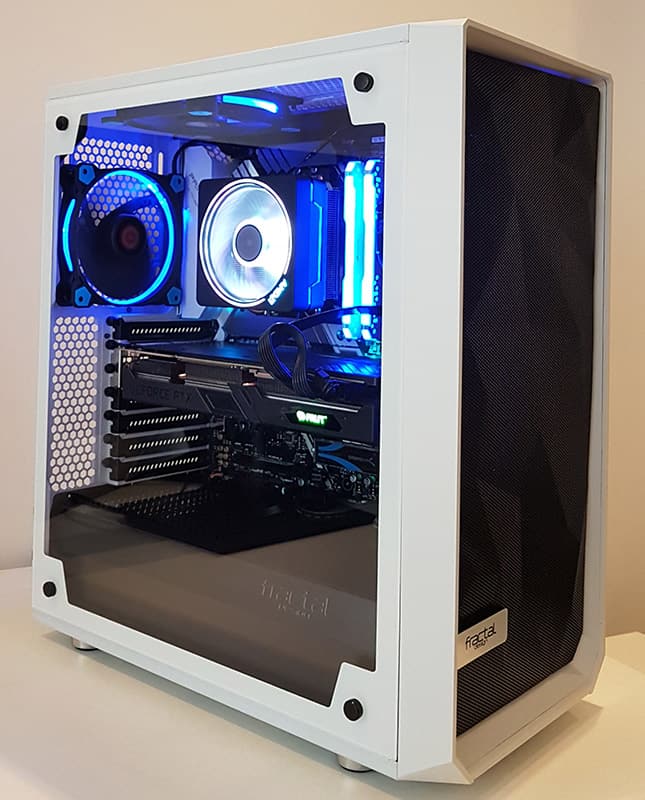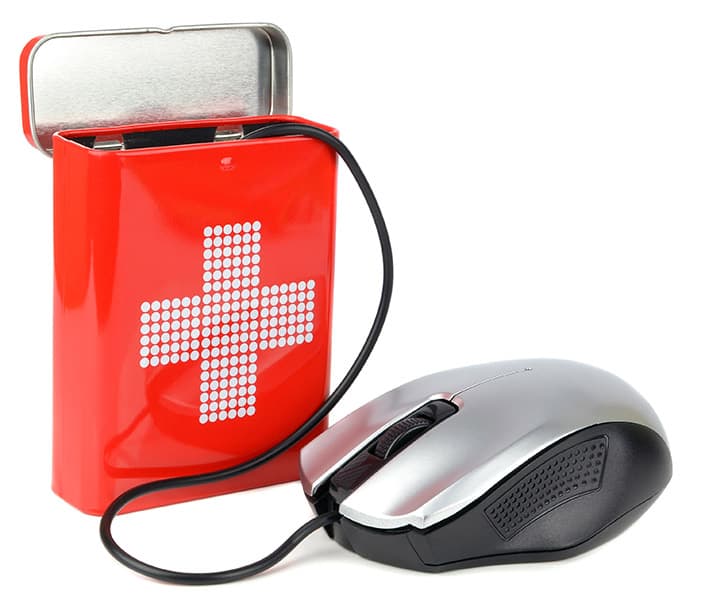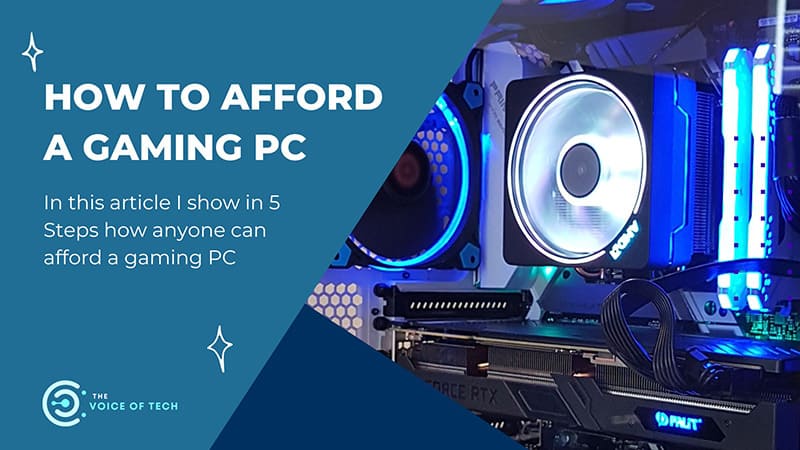
Expert Consulted: Adrian Gardiner. I’m drawing on my own 30 years of experience in the IT industry to write this article, having built many new, refurbished, and upgraded computers for my customers. For this article, I’m using my knowledge to show you how to afford a gaming PC in 5 easy steps.
With the right approach, I think anyone can afford a gaming PC and here I’ll show you how, in 5 easy steps that involve deciding on a realistic budget, showing you a number of different ways to get an affordable PC, the key computer parts you need, the minimum specifications to aim for and where you can buy affordable computers and/or computer parts.
Related Articles:
Check out how to make your Gaming PC last as long as possible
How to Avoid the Top 45 PC Building Mistakes
How to Afford a Gaming PC in 5 Easy Steps – Full Details
The following sections will show how you can afford a gaming PC in 5 easy steps that anyone can take.
Step 1: Decide on Your Budget

As a guide, if buying new:
Entry Level: Budget for around $500 to get a basic entry-level gaming PC.
Mid Range: Budget for around $1000 to get a mid-spec. PC that is capable of playing all of the latest and most popular games at a good resolution and FPS (frames per second).
High End.: Budget for around $2000 to get a high-end, advanced spec. PC that is capable of playing all of the latest and most popular games, often at maximum settings for resolution, FPS, and minimal input delay, etc.
NOTE: These prices are a guide only as there are always deals everywhere with chances to save money if you’re prepared to wait.
If you buy second-hand, your prices could be considerably lower. Alternatively, your budget may be higher, allowing you to spend more on a top-end graphics card or processor for example.
Step 2: Ways to Afford Your Gaming PC
- If you’re still at school and not earning yet, ask your parents if you can get paid jobs around the home
- You could get a paper round, mow the neighbor’s lawn, or clean their car. There are many jobs you can do that will help you afford a gaming PC
- For Christmas and Birthdays, ask for cash instead of gifts – I did this with my own children
- Build the PC yourself, perhaps with a friend or relative, and save money on the labor cost built into a pre-built PC. There are many guides on the web that show how to do this
- If you already have a computer but it’s slow, consider upgrading it with more RAM and a graphics card
- Buy second-hand / refurbished computers and/or computer parts off sites like eBay. I have done this for clients looking to save money and there are incredible bargains to be had if you look
- Choose your computer specification carefully to see what hardware you need to be able to play a particular game. You might not need that fancy graphics card after all! Go to: www.systemrequirementslab.com to analyze your computer and check it against a particular game or use this site to find out what specification you need for your computer to play your favorite game
- Buy your computer parts gradually, one part at a time until you have enough to start building
- Look out for relatives and family members getting rid of perfectly fine computers when deciding to upgrade to a laptop because they want to free up space in the home. More common than you think and could give you a good head start at little to no cost
- If you’re at College / University, check to see if you can get student discounts on computers
- Wait for back-to-school and winter holiday sales
- Buy a cheap pre-built computer and upgrade it with more RAM and a graphics card.
Step 3: Key parts required for your Gaming PC

- Computer case – I recommend at least a Micro ATX Mid Tower (mATX) case to ensure the minimum amount of space for parts and cooling. Note: Some of the larger (longer) graphics cards may not fit in this case – you’ll need to check the dimensions of the card and internal space available if carrying out a self-build
- Motherboard – ideally will need to be an mATX board to match an mATX case as mentioned above
- CPU / Processor – AMD or Intel processors are both fine but I recommend AMD Ryzen processors for gaming as they usually offer more bang for your buck
- CPU / Processor Heatsink and Cooling Fan
- Case Cooling Fan(s) as required
- RAM – DDR4 or DDR5 on newer high-end computers
- SSD (solid state drive) – much faster than old-fashioned spinning hard disk drives
- Graphics Card (a CPU with integrated graphics may suffice for some games to start off with allowing you to add a separate graphics card later when funds allow
- PSU – For new builds don’t skimp on a good quality power supply unit if you are able. For safety and reliability, I recommend buying a new PSU if you are using a second-hand computer
- Mouse – A wireless mouse is best here, with no restricting and annoying cable getting in the way
- Keyboard – ideally a mechanical keyboard as this gives the best performance but can be noisy for nearby siblings, parents, or friends!
- Computer Monitor – Aim for 24” minimum (measured across the diagonal, screen corner to corner)
- Separate speakers or headphones – to save my sanity, my children both had headphones to keep the noise down!
Step 4: Minimum Gaming PC Specifications to Aim for
The following specification guides will give you a good target to aim for. These are ideal targets and not set in stone.
To play a particular game you may need less power than you think. Check what you need to play a particular game by visiting: www.systemrequirementslab.com.
| Entry Level: $500 | 8 GB DDR4 RAM min. (I find the current versions of Windows 10 and 11 can run very slow on 4 GB RAM), AMD Ryzen 3 CPU, GeForce GTX 1650 SUPER 4 GB, 1 TB M.2 NVMe SSD drive |
| Mid Range: $1000 | 16 GB DDR4 RAM min., Intel i7 or AMD Ryzen 7 CPU, nVidia RTX 3050, 1 TB M.2 NVMe SSD drive |
| High End: $2000 | 32 GB DDR5 RAM, Intel i9 or AMD Ryzen 9 CPU, nVidia RTX 4070, 2 TB M.2 NVMe SSD drive |
NOTE: These specs are ideal goals to aim for at the price points mentioned. Some games will run with a lower spec. CPU and integrated graphics allow you to save money for a separate graphics card later on.
Higher specifications / better quality components mean better display quality, higher levels of detail, faster response times, and a more realistic gameplay experience allowing you to play the latest games at maximum capability.
Step 5: Where to buy lower-priced second-hand computers and parts
- eBay.com – computers and parts. I only use sellers with feedback ratings over 99% who have been around for over 5 years to ensure a smooth and safe buying experience. Many big retailers have a shop on eBay, often with prices cheaper than instore and offer warranties on refurbished PCs
- Amazon.com – competitive prices for both new and refurbished computers
- Craigslist.org
- Gumtree – I’ve bought older gaming and non-gaming computers from here and upgraded them
- Bestbuy.com (refurbished computers)
- Facebook Marketplace
- Reddit.com
- For sale items in your local newsagent/store. Newsagents local to me have a noticeboard where anyone can sell pretty much anything, including computers for example.
- Garage Sale Apps.
How to Test a Second-Hand PC
When buying a second-hand PC always make sure you see it working before parting with your money.
Go with a friend or relative to keep the seller talking, giving you a chance to properly examine the PC. The following checks should be carried out if possible:

- RAM – Test by using the Windows search bar to find the ‘Windows Memory Diagnostic app. Open the App and then click ‘Restart Now and Check for Problems’.
- Hard Drive – Check System Event Log (Administrative Tools > Event Log > System) for disk errors.
- CPU – Check CPU (use free Core Temp or HW Monitor programs) and GPU temperatures (Task Manager will show the GPU temperature). If time allows.
- Dust – Check for the presence of excessive dust inside the case – if you can see it from the outside then it will be a lot worse inside! If there is a serious build-up of dust I would usually walk away as the computer has not been looked after and there will be a good chance of heat-related issues later on.
Note: You can often gauge the condition of a PC by the outside condition of the case – if it’s nice and clean with no scuffs and marks and all buttons work well, no excessive visible dust, etc. then there’s a good chance the internals will be reasonable too – not always but it can be a useful indicator.
Still carry out the above checks though just to be safe.
Conclusion
If you decide on a realistic budget, identify how you are going to get your computer i.e., refurbished, self-build or a new pre-built PC, and then take the time to look around for the best deals and offers, you’ll find it definitely possible for anyone to afford a gaming PC.
Image Attribution and Licencing
2022-11-16-22-03-58-utc, Saving and Taxation, by Ashishk75, Envato
2021-08-26-15-50-33-utc, Computer Health, by gcpics, Envato

